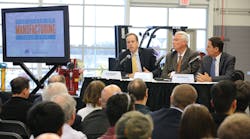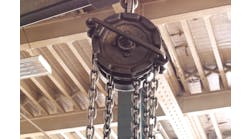Jay Timmons, president and CEO of the National Association of Manufacturers, delivered his annual state of manufacturing address on Feb. 3 in the manufacturing lab at Harper College in Palatine, Ill. The event, co-hosted by the Illinois Manufacturers’ Association and Harper College, was the latest stop in its State of Manufacturing Tour 2016 throughout seven states to highlight the vital role that industry plays in the U.S. economy and the changing perceptions of manufacturing.
"Today’s modern manufacturing doesn’t always look like yesterday’s," said Timmons. "We're sleek, high-tech and innovative, and manufacturers continue to drive economic growth in the U.S. Manufacturing is leading an innovation revolution that will win jobs for America, raise standards of living and restore our nation’s standing around the world. Modern manufacturing touches every aspect of our lives, and it’s the backbone of our economy. Our industries are about the men and women who make things in America; it’s about their creativity and the potential we can unleash. Now is the time to embrace a manufacturing resurgence to protect and promote American exceptionalism."
To describe some of the challenges and opportunities facing U.S. manufacturers, (l. to r.) David Etzwiler, president of the Siemens Foundation, Greg Baise, president and CEO of the Illinois Manufacturers' Association (IMA) and Jay Timmons, president and CEO of the National Association of Manufacturers (NAM), participated in a Feb. 3 panel discussion in the manufacturing lab at Harper College in Palatine, Ill., which is one stop on NAM's State of Manufacturing Tour 2016. Photo by David Bohrer/NAM
During this year's tour, Timmons is visiting with local manufacturers, employees, students, business and community leaders and elected officials across New Hampshire, Florida, South Carolina, Pennsylvania, Illinois, Texas and Maryland, and highlighting the real-world solutions needed for the U.S. economy and its manufacturers to thrive. Manufacturing supports an estimated 18.5 million jobs in the U.S., including 573,700 jobs in Illinois, and contributes $2.17 trillion to the U.S. economy.
Timmons also showcased “Competing to Win: Manufacturers’ Agenda for Economic Growth and American Exceptionalism,” which is NAM's roadmap to guide manufacturing voters and candidates as they navigate the upcoming elections. It outlines challenges manufacturers face as well as public policy solutions. The roadmap covers tax, trade, energy, environment, transportation and infrastructure, labor, immigration, workforce, healthcare, research, innovation and technology, and regulatory and legal reform.
"It's great to welcome the National Association of Manufacturers to Illinois as part of its state tour," added Illinois Lt. Gov. Evelyn Sanguinetti, who joined Timmons at Harper College for the event. "Manufacturing is embedded in the fabric of our state and has been since the Industrial Revolution. Illinois holds great potential for the future of industry, and Harper College is a great place to highlight it."
Greg Baise, IMA's president and CEO, added, "Manufacturing is critical to the success of Illinois and the U.S. Our sector employs nearly 600,000 workers in good, high-paying jobs that comprise our nation’s middle class. There is no doubt that the spirit, innovation and ingenuity of American manufacturers allow them to make the best products and compete with anyone in the world. Today, we saw firsthand how focused programs of study can prepare a highly skilled workforce to compete in today's global economy featuring advanced manufacturing. We've made great strides, but many challenges continue at both the state and federal level. In Illinois alone, we need to replace 26,000 production workers and 5,000 engineers every single year between now and the end of 2027. For that to happen, policymakers must take decisive action to enact a strategic and sustainable plan that will create a strong education and workforce development system, reduce intrinsic costs, and reform the tax code so American companies can compete on a level playing field."






